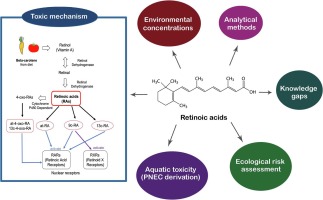当前位置:
X-MOL 学术
›
Environ. Int.
›
论文详情
Our official English website, www.x-mol.net, welcomes your feedback! (Note: you will need to create a separate account there.)
Current understanding of potential ecological risks of retinoic acids and their metabolites in aquatic environments.
Environment International ( IF 11.8 ) Pub Date : 2020-01-08 , DOI: 10.1016/j.envint.2020.105464 Katie Wan Yee Yeung 1 , Guang-Jie Zhou 1 , Klára Hilscherová 2 , John P Giesy 3 , Kenneth Mei Yee Leung 4
Environment International ( IF 11.8 ) Pub Date : 2020-01-08 , DOI: 10.1016/j.envint.2020.105464 Katie Wan Yee Yeung 1 , Guang-Jie Zhou 1 , Klára Hilscherová 2 , John P Giesy 3 , Kenneth Mei Yee Leung 4
Affiliation

|
In animals, retinoic acids (RAs), one of the main derivatives of vitamin A, are crucial for a variety of physiological processes. RAs, including all-trans-RA, 9-cis-RA, 13-cis-RA, and their corresponding metabolites (i.e., all-trans-4-oxo-RA, 9-cis-4-oxo-RA and 13-cis-4-oxo-RA) can be excreted through urination from humans and animals. Sewage treatment plants (STPs) are a significant source of RAs and 4-oxo-RAs into aquatic environments. RAs and 4-oxo-RAs can be identified and quantified by use of liquid chromatography coupled with tandem mass spectrometry (LC-MS/MS). RAs and 4-oxo-RAs have been reported in various environmental matrices including rivers, lakes, reservoirs and coastal marine environments as well as in sewage effluents discharged from STPs. Greater concentrations of RAs and 4-oxo-RAs have been observed during blooms of cyanobacteria and microalgae, suggesting that cyanobacteria and microalgae are natural sources of RAs and 4-oxo-RAs in aquatic environments. These potential sources of RAs and 4-oxo-RAs raise concerns about their concentrations and risks in aquatic environments because excessive intake of these chemicals can result in abnormal morphological development in animals. Teratogenic effects were observed in amphibians, fish embryos, gastropods, mammals and birds when exposed to RAs. This review summarizes sources, concentrations, adverse effects and ecological risks of RAs and 4-oxo-RAs in aquatic environments. An interim, predicted no-effect concentration (PNEC) of RAs (in terms of at-RA) for freshwater environments was determined to be 3.93 ng/L at-RA equivalents. Based on limited data on concentrations of RAs in freshwater ecosystems, their hazard quotients were found to range from zero to 16.41, depending on the environmental conditions of receiving waters. Ecological risks of RAs in marine environments are yet to be explored due to the paucity of data related to both their concentrations in marine environment and toxic potencies to marine species. This review updates current knowledge of RAs and 4-oxo-RAs in aquatic environments and calls for more studies on their concentrations and fate in aquatic environments, especially estuarine and coastal marine environments with a view to enabling a comprehensive assessment of their ecological risks around the globe.
中文翻译:

目前对水生环境中视黄酸及其代谢物潜在的生态风险的了解。
在动物体内,维生素A的主要衍生物之一维甲酸(RAs)对多种生理过程至关重要。RA,包括全反式RA,9-顺式-RA,13-顺式-RA及其相应的代谢物(即全反式4-氧代-RA,9-顺式4-氧代-RA和13- cis-4-oxo-RA)可以通过排泄从人类和动物中排泄。污水处理厂(STP)是水生环境中RA和4-氧代RA的重要来源。可以使用液相色谱和串联质谱(LC-MS / MS)鉴定和定量RA和4-oxo-RA。在各种环境矩阵中,包括河流,湖泊,水库和沿海海洋环境,以及从污水处理厂排放的污水中,都报告了RA和4-oxo-RA。在蓝细菌和微藻开花期间观察到较高浓度的RA和4-氧代-RA,这表明在水生环境中,蓝细菌和微藻是RA和4-氧代-RA的天然来源。这些潜在的RA和4-氧代RA的来源引起人们对其在水生环境中的浓度和风险的担忧,因为过量摄入这些化学物质会导致动物形态学发育异常。当暴露于RA时,在两栖动物,鱼类胚胎,腹足动物,哺乳动物和鸟类中观察到致畸作用。这篇综述总结了水生环境中RA和4-氧代RA的来源,浓度,不利影响和生态风险。确定了淡水环境中RA的临时预测无效应浓度(PNEC)(以at-RA计)为3.93 ng / L at-RA当量。根据有关淡水生态系统中RA浓度的有限数据,发现它们的危险系数范围从零到16.41,这取决于接收水的环境条件。由于缺乏有关RA在海洋环境中的浓度以及对海洋物种的毒性的数据,因此尚需探索RA在海洋环境中的生态风险。这篇综述更新了水生环境中RA和4-氧代RA的当前知识,并呼吁对其在水生环境(尤其是河口和沿海海洋环境)中的浓度和命运进行更多的研究,以期全面评估其在周围环境中的生态风险。地球。取决于接收水的环境条件。由于RAs在海洋环境中的浓度以及对海洋物种的毒性,有关RAs在海洋环境中的生态风险尚待探讨。这项审查更新了水生环境中RA和4-氧代RA的当前知识,并呼吁对其在水生环境(尤其是河口和沿海海洋环境)中的浓度和命运进行更多的研究,以期全面评估其在周围环境中的生态风险。地球。取决于接收水的环境条件。由于RAs在海洋环境中的浓度以及对海洋物种的毒性,有关RAs在海洋环境中的生态风险尚待探讨。这项审查更新了水生环境中RA和4-氧代RA的当前知识,并呼吁对其在水生环境(尤其是河口和沿海海洋环境)中的浓度和命运进行更多的研究,以期全面评估其在周围环境中的生态风险。地球。
更新日期:2020-01-08
中文翻译:

目前对水生环境中视黄酸及其代谢物潜在的生态风险的了解。
在动物体内,维生素A的主要衍生物之一维甲酸(RAs)对多种生理过程至关重要。RA,包括全反式RA,9-顺式-RA,13-顺式-RA及其相应的代谢物(即全反式4-氧代-RA,9-顺式4-氧代-RA和13- cis-4-oxo-RA)可以通过排泄从人类和动物中排泄。污水处理厂(STP)是水生环境中RA和4-氧代RA的重要来源。可以使用液相色谱和串联质谱(LC-MS / MS)鉴定和定量RA和4-oxo-RA。在各种环境矩阵中,包括河流,湖泊,水库和沿海海洋环境,以及从污水处理厂排放的污水中,都报告了RA和4-oxo-RA。在蓝细菌和微藻开花期间观察到较高浓度的RA和4-氧代-RA,这表明在水生环境中,蓝细菌和微藻是RA和4-氧代-RA的天然来源。这些潜在的RA和4-氧代RA的来源引起人们对其在水生环境中的浓度和风险的担忧,因为过量摄入这些化学物质会导致动物形态学发育异常。当暴露于RA时,在两栖动物,鱼类胚胎,腹足动物,哺乳动物和鸟类中观察到致畸作用。这篇综述总结了水生环境中RA和4-氧代RA的来源,浓度,不利影响和生态风险。确定了淡水环境中RA的临时预测无效应浓度(PNEC)(以at-RA计)为3.93 ng / L at-RA当量。根据有关淡水生态系统中RA浓度的有限数据,发现它们的危险系数范围从零到16.41,这取决于接收水的环境条件。由于缺乏有关RA在海洋环境中的浓度以及对海洋物种的毒性的数据,因此尚需探索RA在海洋环境中的生态风险。这篇综述更新了水生环境中RA和4-氧代RA的当前知识,并呼吁对其在水生环境(尤其是河口和沿海海洋环境)中的浓度和命运进行更多的研究,以期全面评估其在周围环境中的生态风险。地球。取决于接收水的环境条件。由于RAs在海洋环境中的浓度以及对海洋物种的毒性,有关RAs在海洋环境中的生态风险尚待探讨。这项审查更新了水生环境中RA和4-氧代RA的当前知识,并呼吁对其在水生环境(尤其是河口和沿海海洋环境)中的浓度和命运进行更多的研究,以期全面评估其在周围环境中的生态风险。地球。取决于接收水的环境条件。由于RAs在海洋环境中的浓度以及对海洋物种的毒性,有关RAs在海洋环境中的生态风险尚待探讨。这项审查更新了水生环境中RA和4-氧代RA的当前知识,并呼吁对其在水生环境(尤其是河口和沿海海洋环境)中的浓度和命运进行更多的研究,以期全面评估其在周围环境中的生态风险。地球。



























 京公网安备 11010802027423号
京公网安备 11010802027423号